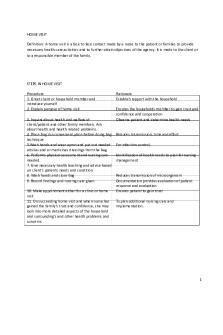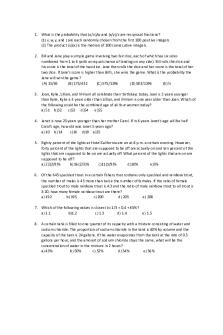W21 SYSC2100 Lab4 - ADT Dictionary Bag PDF

| Title | W21 SYSC2100 Lab4 - ADT Dictionary Bag |
|---|---|
| Course | Algorithms and Data Structures |
| Institution | Carleton University |
| Pages | 4 |
| File Size | 159.6 KB |
| File Type | |
| Total Downloads | 41 |
| Total Views | 133 |
Summary
ADT Dictionary Bag...
Description
Carleton University Department of Systems and Computer Engineering SYSC 2100 — Algorithms and Data Structures — Winter 2021 Lab 4 - ADT Bag (Implemented Using a Dictionary) Submitting Lab Work for Grading Remember, you don’t have to finish the lab by the end of your lab period. For this lab, the deadline for submitting your solutions to cuLearn for grading is 11:55 pm (Ottawa time) two days after your scheduled lab. Solutions that are emailed to your instructor or a TA will not be graded, even if they are emailed before the deadline. Please read Important Considerations When Submitting Files to cuLearn , on the last page of the course outline. References ● Problem Solving with Algorithms and Data Structures using Python, Third Edition, Section 1.8.2, Built-in Collection Data Types (the discussion of Python's built-in dictionary collection, type dict ) and Section 3.7, Dictionaries . For this lab, you don't need to know how to build experiments using Python's timeit module. You should understand the Big-Oh characterization of the operations (operators, functions and methods) provided by Python's built-in dict type.
ict ● Python Standard Library, Mapping Types - d ○ URL: https://docs.python.org/3/library/stdtypes.html#mapping-types-dict ADT Bag - Specification A bag is a simple container that stores a collection of items. Duplicate items are permitted. The ordering of the items isn't specified (it depends on the bag's implementation). The items must be comparable. (In this lab, all the items will be values of type str ). ADT Bag provides the following operations: ● ● ● ● ●
create a new, empty bag. to-string: return a printable string representation of the bag's contents. add: place the specified item in the bag. length: return the number of items stored in the bag. contains: determine if a specified item is in the bag and return the appropriate boolean value. ● count: return the total number of occurrences of a specified item (0 if the item isn't in the bag). ● remove: remove and return one occurrence of the specified item from the bag. Raises an exception if the bag is empty or the item isn't in the bag. 1
● grab: remove and return a randomly selected item from the bag. Raises an exception if the bag is empty. This operation will not be implemented in this lab. ● iterator: create and return an iterator that can be used to iterate over the collection. ADT Bag - Implementation Many data structures could be used to implement ADT Bag. For this lab, you'll use a Python dictionary (class dict ) as the ADT's underlying data structure (we'll investigate other implementations later in the course). A Bag object will have one instance variable, _items , which will refer to an instance of class dict . The bag's contents will be stored in this dictionary. Recall that a dictionary is a collection of key/value pairs. Each item stored in a bag will be the key part of a key/value pair in the dictionary. A counter will be stored in the value part. This counter will keep track of the number of occurrences of the corresponding item in the bag. When a duplicate item is added, the counter is incremented; when a duplicate is removed, the counter is decremented. The references listed earlier describe the operations (operators, functions, methods) provided by type dict . Log on to cuLearn and download dictbag.py from the Lab Materials section of the main course page. Open this file in Wing 101. It contains an incomplete implementation of class Bag . Two methods have been completed for you: ● __str__ returns a string representation of the bag. This method is simple: return str(self._items) Instance variable _items refers to the dict that stores the bag's contents. The method simply returns the string returned by the underlying dictionary's __str__ method. ● __iter__ returns an object that can be used to iterate over the bag. In other words, if shopping_bag refers to an instance of Bag , you can write: for item in shopping_bag: # Print the bag's contents one-by-one. print(item) A bag's iterator returns a sequence of the key/value pairs in the bag's dictionary. Each key/value pair is returned in a tuple. See the method's docstring for an example. "Stub" implementations have been provided for the other methods. If you call any of these methods on a Bag object, Python will throw a NotImplementedError exception. When implementing the methods, take advantage of the operations provided by type dict . All the methods, except remove , can be implemented with a single statement (but it's ok to have more than one statement in your function bodies). Hint: none of the methods require for 2
loops or while loops. Exercise 1: Read the docstring for __init__ . A Bag object should have one instance variable, names _items , which is initialized to an empty instance of Python's dict type. Replace the raise statement with a correct implementation of the method. Use this test to check if your method is correct: >>> bag = Bag() >>> bag._items {} # Shows that _items refers to an empty dict. Exercise 2: Read the docstring for __repr__ . Replace the raise statement with a correct implementation of the method. Use the shell to test __repr__ . (You'll only be able to test if __repr__ works with an empty bag, because we don't yet have a way to put items in a bag.) Exercise 3: Read the docstring for add . Replace the raise statement with a correct implementation of the method. Use the shell to test add . Now that you can put items in a bag, you can also verify that __repr__ works with a bag that contains one or more items. You should also run the example in the docstring for __iter__ , to convince yourself that we can iterate over the items in a bag. Exercise 4: Try this experiment: >>> bag = Bag() >>> len(bag) In order for Python's built-in len function to work with Bag objects, we need to define a __len__ method in the class. Read the docstring for __len__. Replace the raise statement with a correct implementation of the method. Use the shell to test __len__ . Exercise 5: Try this experiment: >>> bag = Bag() >>> 'k' in bag In order for Python's in operator to work with Bag objects, we need to define a __contains__ method in the class. Read the docstring for __contains__ . Replace the raise statement with a correct implementation of the method. Use the shell to test __contains__ . Exercise 6: Read the docstring for count . Replace the raise statement with a correct implementation of the method. Use the shell to test count . Exercise 7: Read the docstring for remove . Replace the raise statement with a correct implementation of the method. ● When the bag is empty, the method should raise a KeyError exception that displays the message, "bag.remove(x): remove from empty bag". 3
● When the bag has no instances of the item we want to remove, the method should raise a ValueError exception that displays the message, "bag.remove(x): x not in bag". Use the shell to test remove .
Wrap Up Please read Important Considerations When Submitting Files to cuLearn , on the last page of the course outline. The submission deadlines for this lab are: Lab Section
Lab Date/Time
Submission Deadline (Ottawa Time)
L5
Tuesday, 11:35 - 13:25
Thursday, Feb. 4, 23:55
L2
Thursday, 9:35 - 11:25
Saturday, Feb. 6, 23:55
L4
Thursday, 12:35 - 14:25
Saturday, Feb. 6, 23:55
L3
Friday, 9:35 - 11:25
Sunday, Feb. 7, 23:55
L1
Friday, 14:35 - 16:25
Sunday, Feb. 7, 23:55
To submit your lab work, go to the cuLearn page for your lab section (not the main course page). Submit dictbag.py . Ensure you submit the version of the file that contains your solutions, and not the unmodified file you downloaded from cuLearn! You are permitted to make changes to your solutions and resubmit the file as many times as you want, up to the deadline. Only the most recent submission is saved by cuLearn.
Last edited: Jan. 31, 2021
4...
Similar Free PDFs

ADT unit 2 notes - adt
- 38 Pages

BAG- Technique - RLE Bag
- 7 Pages

Practica Catalogo ADT - copia
- 10 Pages

Mixed Bag
- 4 Pages

Fallacies Dictionary
- 2 Pages

S11175511 LAB4 CH204 2020
- 6 Pages

Lab4 - lab report
- 14 Pages

Lab4 advanced programming
- 16 Pages

Modul 01 - ADT
- 5 Pages

R Dictionary
- 1 Pages

MCDB1B W21 Syllabus-v2
- 5 Pages

Latin dictionary
- 42 Pages

Textile Dictionary
- 210 Pages

cnc LAB4 g-code
- 6 Pages

Lab4 solns - 380CT
- 9 Pages
Popular Institutions
- Tinajero National High School - Annex
- Politeknik Caltex Riau
- Yokohama City University
- SGT University
- University of Al-Qadisiyah
- Divine Word College of Vigan
- Techniek College Rotterdam
- Universidade de Santiago
- Universiti Teknologi MARA Cawangan Johor Kampus Pasir Gudang
- Poltekkes Kemenkes Yogyakarta
- Baguio City National High School
- Colegio san marcos
- preparatoria uno
- Centro de Bachillerato Tecnológico Industrial y de Servicios No. 107
- Dalian Maritime University
- Quang Trung Secondary School
- Colegio Tecnológico en Informática
- Corporación Regional de Educación Superior
- Grupo CEDVA
- Dar Al Uloom University
- Centro de Estudios Preuniversitarios de la Universidad Nacional de Ingeniería
- 上智大学
- Aakash International School, Nuna Majara
- San Felipe Neri Catholic School
- Kang Chiao International School - New Taipei City
- Misamis Occidental National High School
- Institución Educativa Escuela Normal Juan Ladrilleros
- Kolehiyo ng Pantukan
- Batanes State College
- Instituto Continental
- Sekolah Menengah Kejuruan Kesehatan Kaltara (Tarakan)
- Colegio de La Inmaculada Concepcion - Cebu
